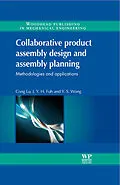Collaborative product assembly design and assembly planning presents several newly-developed methodologies and applications for collaborative assembly design and assembly planning, two important steps during the product development life cycle. These benefits include effective and rapid assembly design and assembly planning, thereby reducing the development cost and helping manufacturers enhance profit. With increased development in computer technologies and the Internet, the traditional assembly design and assembly planning have evolved around collaborative assembly design and assembly planning to speed up the product development process. Research in this area has attracted much attention in the past decade. Based on research work in the past few years, this book will present several newly-developed methodologies and applications for collaborative assembly design and assembly planning to improve the efficiency of product development in a collaborative design environment. - Provides practical and realistic solutions to engineering problems - Methodologies introduced will lead to future commercialisation of systems - Detailed step-by-step case study examples will illustrate the methodologies and be discussed thoroughly
Autorentext
Dr. Cong Lu is currently an associate Professor in the School of Mechatronics Engineering, University of Electronic Science and Technology of China. Dr. Lu's research interests include collaborative design and assembly, concurrent Engineering, and CAD/CAM. Dr. Lu has published many research papers in the reputable international journals, such as ASME Journal of Computing and Information Science in Engineering, IMechE Journal of Engineering Manufacture, International Journal of Production Research.
Inhalt
List of figures, tables and lists
Acknowledgements
Preface
About the authors
Chapter 1: Introduction
Abstract:
1.1 Background
1.2 Key issues in collaborative assembly design
1.3 Key issues in collaborative assembly planning
1.4 Organization of the book
Chapter 2: Literature survey
Abstract:
2.1 Survey on assembly design
2.2 Survey on evaluation of the tolerance influence on product assemblability
2.3 Survey on assembly planning
2.4 Research works in this book
Chapter 3: Collaborative assembly design
Abstract:
3.1 An assembly representation model for collaborative design
3.2 Functions of the co-assembly representation model
3.3 Design modification propagation control mechanism
3.4 System implementation
3.5 Case study
3.6 Summary
Chapter 4: Evaluation of product assemblability in different assembly sequences
Abstract:
4.1 Tolerance categorization and representation
4.2 Clearance in assembly and representation
4.3 Using transformation matrices to conclude the propagation and accumulation of the geometric deviations
4.4 Assemblability evaluation in different assembly sequences
4.5 Case study
4.6 Summary
Chapter 5: Advanced assembly planning approach using a multi-objective genetic algorithm
Abstract:
5.1 Tolerance-based constraint in assembly planning
5.2 Genetic search directions with fuzzy weights distribution
5.3 Multi-objective genetic algorithm with multiple search directions
5.4 Building the fitness function for assembly planning
5.5 Case study
5.6 Summary
Chapter 6: Evaluation of assembly design from assembly planning redesign
Abstract:
6.1 The design problems identified from the assembly planning results
6.2 The overall redesign guidelines from the assembly planning results
6.3 Summary
Chapter 7: Collaborative assembly planning
Abstract:
7.1 System framework and working mechanism
7.2 The workflow of collaborative assembly planning
7.3 Case study
7.4 Summary
Chapter 8: Conclusions and recommendations
Abstract:
8.1 Conclusions
8.2 Recommendations for future works
Index
